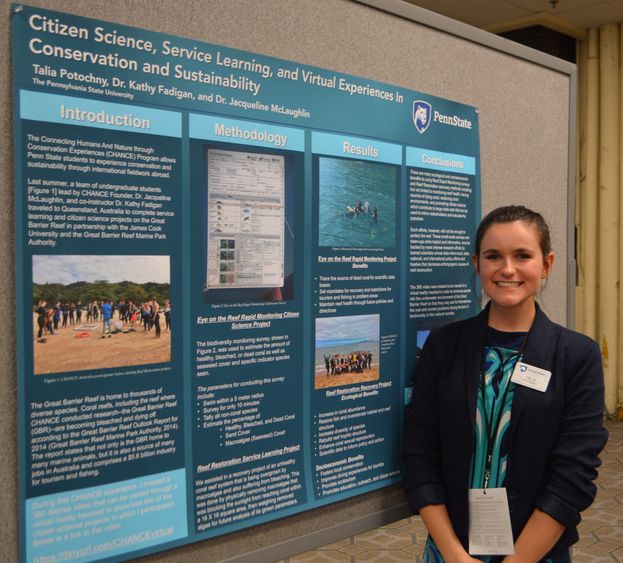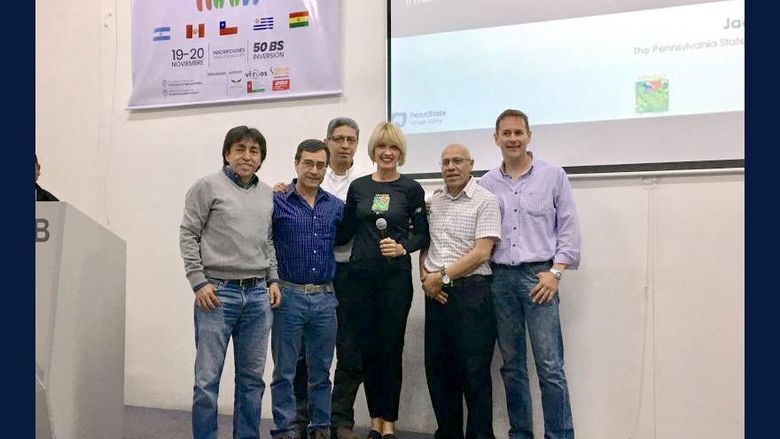
Talia Potochny presented a poster titled “Citizen Science, Service Learning, and Virtual Experiences in Conservation and Sustainability” at the American Association of Geographers Conference in Washington, D.C.
CENTER VALLEY, Pa. — At Penn State Lehigh Valley, students have the opportunity to work with esteemed faculty members to complete research at the undergraduate level, and students have ample opportunities to present their research and findings at conferences and regional symposiums. This year some student researchers also were published in peer-reviewed academic journals.
The students from Penn State Lehigh Valley who had their undergraduate research accepted for publication or who presented their research between May 2018 to April 2019 include:
Poster presentations:
— Erica Hughes (class of 2019, health policy and administration), Isabella Hanna (class of 2021, health policy and administration), Jermaine Jones (class of 2021, health policy and administration), Kelly McNally (class of 2021, health policy and administration), Amia Luu (class of 2021, health policy and administration), with Kerry Huzzard (class of 2020, health policy and administration), Maria Mahfoud (class of 2021, health policy and administration), Sean Mcginley (2020, biobehavioral health), Brian Perch (class of 2020, health policy and administration), and Nicole Stopper (class of 2020, health policy and administration) presented a poster titled “'Too Many People are Dying Where I am From' Geography, Gender, and Secondary Exposures to the Opioid Epidemic” on April 18 at the Penn State Eastern Regional Undergraduate Research Symposium at Penn State Hazleton. Their poster placed first in the Social Sciences and Business category. Jennifer Parker, associate professor of sociology, served as faculty mentor. The purpose of the research is to help fill the knowledge gap in university students’ awareness and exposure to the opioid epidemic.
— A’dryanna Jenkins (class of 2021, biochemistry) and Marquis McMillan (class of 2021, physics) co-presented a poster titled “Binding affinity of flavins to riboflavin binding protein using fluorescence spectrometry and isothermal titration calorimetry, and estimated binding energies using computational approaches” on March 31 at the American Chemical Society Meeting in Orlando, Florida. Julie B. Ealy, associate professor of chemistry, assisted and served as the faculty mentor. The research completed the collection of wet bench data from two previous years. ICM-Pro (computational software) was used to determine the estimated binding energy of the fluorescent molecules riboflavin, lumichrome, flavin mononucleotide (FMN), and flavin adenine dinucleotide (FAD) with human folate receptor alpha (4LRH.pdb) that is evolutionarily related to chicken riboflavin binding protein (RBP). Structural analysis of RBP and human folate receptor alpha (HFRA) demonstrated a significant similarity between the two proteins thus indicating similar functions. Two wet bench techniques, isothermal calorimetry titration (ITC) and fluorescence spectrometry, were used to assess the binding affinity of the four flavins with chicken RBP.
— Christian Lopez (class of 2021, information sciences and technology) presented a poster titled “Race, Bullying, and Disciplinary Patterns: A Statistical Model for Examining Racial Bias in Schools” in March 16 at the Eastern Sociological Society 88th Annual Meeting in Boston, Massachusetts. Jennifer Parker, associate professor of sociology, served as faculty mentor. This was a peer-reviewed poster presentation. Lopez presented work that has implications for how people understand the school to prison pipeline and the groups that are most vulnerable to its impact.
— Talia Potochny (class of 2021, geography) presented a poster titled “Citizen Science, Service Learning, and Virtual Experiences in Conservation and Sustainability” in April at the American Association of Geographers (AAG) Conference in Washington D.C. Jacqueline S. McLaughlin, associate professor of biology, served as the faculty mentor, as well as Kathleen A. Fadigan, assistant teaching professor of education from Penn State Abington.
— Brian Perch (class of 2019, health policy and administration) and Nicole Stopper (class of 2020, health policy and administration) presented a poster titled “Atul Gawande’s Chance to Improve American Healthcare” on April 18 at the Penn State Eastern Regional Undergraduate Research Symposium at Penn State Hazleton. Their poster placed second in the Social Sciences and Business category. Anita Yuskauskas, program coordinator of and instructor in health policy and administration, served as faculty mentor. This case study sought to analyze and examine the recently announced formation of a healthcare company owned by Amazon, Berkshire Hathaway, and J.P. Morgan Chase. Led by the innovative surgeon and health care researcher Atul Gawande, this venture presented a potentially seismic force for disruption in the employer-sponsored health care market. The case study provided a better understanding of the dynamics currently at work in the business of health care and identifies promising avenues for future research.
— Elise Schaffer (class of 2019, arts administration) presented a poster titled “Accessibility in Arts Spaces: How Modern Technology and Creative Adaptations Promote Inclusion” on April 18 at the Penn State Eastern Regional Undergraduate Research Symposium at Penn State Hazleton. Schaffer’s poster placed first in the Arts and Humanities category. Elizabeth Flaherty, associate teaching professor of art history and program coordinator of arts administration, served as faculty mentor. The purpose of this research was to determine how forward-thinking arts venues in the United States use modern technologies to create experiences for people with disabilities that are more accessible and inclusive while remaining specific to the organization’s overall function.
— Michael Vanyo (class of 2020, physics) co-presented poster titled “Trends in SABER Kinetic Temperatures and Groundbased Airglow Temperature Measurements in Comparison to Model Simulations” on Dec. 13, 2018, at the 2018 AGU Fall Meeting in Washington, D.C. Tai-Yin Huang, professor of physics, served as faculty mentor and co-presenter. Huang and Vanyo’s research explored trends in the airglow temperatures by anthropogenic gas emissions and natural variability like solar cycle variations and geomagnetic activity were deduced from model simulations and compared to those deduced from ground based and satellite temperature observations.
Presentations:
— Jamil Henderson (class of 2021, electrical engineering) co-presented a talk titled “On Oxygen Airglow Chemistry - Empirical Values of Branching Ratios in the Three-Body Recombination Reaction” on April 11 at the European Geophysical Union General Assembly Meeting in Vienna, Austria. Tai-Yin Huang, professor of physics, served as faculty mentor and co-presenter. There were three other co-presenters including Yolian Amaro-Rivera, Penn State graduate student in electrical engineering; Julio Urbina, associate professor of electrical engineering from Penn State University; and Fabio Vargas, research scientist from University of Illinois at Urbana-Champaign. Their research explored how empirical values of branching ratios in oxygen airglow are deduced from satellite airglow observations. They investigated if the branching ratios depend on location, local time, season, solar cycle variation, geomagnetic activity, and altitude.
— Jamil Henderson (class of 2021, electrical engineering) co-presented a talk titled “Air Light: Understanding its Make-up” on Dec. 12, 2018, at the 2018 AGU Fall Meeting in Washington, D.C. Tai-Yin Huang, professor of physics, served as faculty mentor and co-presenter. There were two other co-presenters, including Yolian Amaro-Rivera, Penn State graduate student in electrical engineering, and Julio Urbina, associate professor of electrical engineering from Penn State. Their research explored how empirical values of branching ratios in oxygen airglow are deduced from satellite airglow observations. They investigated if the branching ratios depend on location, local time, season, solar cycle variation, geomagnetic activity, and altitude.
— Erica Hughes (class of 2019, health policy and administration), presented "Prescription Drug Use and Secondary Exposure Among College Students: A Focus on Gender and Class" on Aug. 11, 2018, at the 113th American Sociological Association Annual Meeting at the Pennsylvania Convention Center in Philadelphia. Jennifer Parker, associate professor of sociology, served as faculty mentor. This peer-reviewed presentation introduced findings from a study on college students' secondary exposures to the opioid epidemic and made suggestions for addressing the epidemic's ripple effects on communities.
— Michael Vanyo (class of 2020, physics) co-presented a talk titled “Airglow Variations by the Influences of CO2 Increase, Solar Cycle Variation, and Geomagnetic Activity” on May 15, 2018, at the 10th Workshop on Long-term Changes and Trends in the Atmosphere at the University of Science and Technology of China in Hefei, China. Tai-Yin Huang, professor of physics, served as faculty mentor and co-presenter. Huang and Vanyo’s research explored trends in the airglow temperatures by anthropogenic gas emissions and natural variability like solar cycle variations and geomagnetic activity were deduced from model simulations and compared to those deduced from ground based and satellite temperature observations.
Undergraduate co-authored research accepted for publication:
— Student co-author Johann Purcell (class of 2017), “What Must A Woman For President Say and Do? The Announcement Videos of Hillary Rodham Clinton 2008-2016.” Media Studies, Vol. 2:14, Fall, 2018. Nichola D. Gutgold, professor of communication arts and sciences, served as co-author and Purcell’s mentor. Naseeba Saeed (class of 2019, corporate communication) conducted census-based research on the status of women and girls in the Lehigh Valley used in the article.
Dennille Schuler
Public Relations Specialist
Penn State Lehigh Valley







